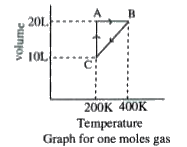For polytropic process PVn = constant, Cm (molar heat capacity) of an ideal gas is given bySolution in Telugu
Cv.m+R(n−1)
Cv,m+R(1−n)
Cv,m+R
Cp,m+R(n−1)
The correct Answer is:B
Cm=dqdT=dUdT−dWdT,CV+PdVdT
PV=RT,PVa=K⇒KVn.V=RT
KVn−1=RT,
K(1−n).V−n.dVdT=R,dVdT=R(1−n)P
⇒Cm=Cv+P.R(1−n)P=CV+R1−n
Topper's Solved these Questions
- CHEMICAL THERMODYNAMICSBook:AAKASH SERIESChapter:CHEMICAL THERMODYNAMICSExercise:LECTURE SHEET (EXERCISE-I) (LEVEL - II (ADVANCED) MORE THAN ONE CORRECT ANSWER TYPE QUESTIONS)
Explore 12 Videos
- CHEMICAL THERMODYNAMICSBook:AAKASH SERIESChapter:CHEMICAL THERMODYNAMICSExercise:LECTURE SHEET (EXERCISE-I) (LEVEL - II (ADVANCED) LINKED COMPREHENSION TYPE QUESTIONS)
Explore 5 Videos
- CHEMICAL THERMODYNAMICSBook:AAKASH SERIESChapter:CHEMICAL THERMODYNAMICSExercise:PRACTICE EXERCISE
Explore 50 Videos
- CHEMICAL THERMODYANMICS Book:AAKASH SERIESChapter:CHEMICAL THERMODYANMICS Exercise:Questions For Descriptive Answers
Explore 28 Videos
- ELECTRON MIGRATION EFFECTS Book:AAKASH SERIESChapter:ELECTRON MIGRATION EFFECTS Exercise:QUESTIONS FOR DESCRIPTIVE ANSWERS
Explore 10 Videos
Similar Questions
The following is/are extensive property/properties
View Solution
Process A→B represents
View SolutionA system has internal energy equal to E1,450J of heat is taken out of it and 600 J of work is done on it. The final energy of the system will be
View SolutionHow does heat of neutralisation value change with the chemical nature of acid and base?
View SolutionHyperconjugation effect is also termed as 'no bond resonance'. Why?
View SolutionA certain ideal gas undergoes a polytropic process PV^(n) = constant such that the molar specific heat during the process is negative. If the ratio of the specific heats of the gas be gamma , then the range of values of n will be
View SolutionA polytropic process for an ideal gas is represented by equation PV^(n) = constant . If g is ratio of specific heats ((C_(p))/(C_(v))) , then value of n for which molar heat capacity of the process is negative is given as
View SolutionFind the molar heat capacity of an ideak gas in a polytropic process pVn=const if the adiabatic exponent of the gas is equal to γ. At what values of the polytropic constant n will the heat capacity of the gas be negative ?
View SolutionFor an ideal gas the ratio of specific heats is (C_(p))/(C_(v)) = gamma . The gas undergoes a polytropic process PV^(n) = a constant. Find the values of n for which the temperature of the gas increases when it rejects heat to the surrounding.
View Solution(a) A polytropic process for an ideal gas is represented by PV^(x) = constant, where x != 1 . Show that molar specific heat capacity for such a process is given by C = C_(v) + (R)/(1-x) . (b) An amount Q of heat is added to a mono atomic ideal gas in a process in which the gas performs a work (Q)/(2) on its surrounding. Show that the process is polytropic and find the molar heat capacity of the gas in the process.
View SolutionAn ideal gas expands according to the law pV2= constant (a) Is it heated or cooled ? (b) What is the molar heat capacity in this process?
View SolutionFor polytropic process PVn = constant, molar heat capacity (Cm) of an ideal gas is given by:
View Solution9.The molar heat capacity of a polytropic process (PV^(n)) is C=C_(v)+(R)/(10) .The value of the polytropic exponent n is ?
View SolutionAn ideal has undergoes a polytropic given by equation PV^(n) = constant. If molar heat capacity of gas during this process is arithmetic mean of its molar heat capacity at constant pressure and constant volume then value of n is
View SolutionFind the molar heat capacity of an ideal gas with adiabatic exponent gamma for the polytorpic process PV^(n)= Constant.
View Solution
